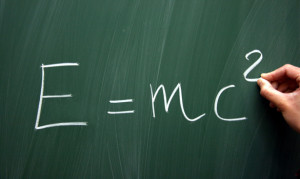
It’s shocking to say that maybe the most renowned scientist in history is not a Scientist. But according to the Value Zodiac model, Albert Einstein was most likely the scientist’s nemesis — the Shaman.
Einstein was a theorist. Theorists are thinkers that use conceptualization to perform educated guesses to discover truth. Theorists often intuit an answer. They stumble onto ideas that seem to “make sense” to them, reflecting the central value theme of harmony that represents the Shaman.
Physicists have long understood that electricity and magnetism were related. The question that faced physicists in Einstein’s time was how electricity and magnetism (E & M) were related to classical Newtonian physics of moving bodies.
The way in which Einstein intuited his way into history highlights Einstein’s Shaman disposition. Einstein started by using the unusual experimental tool of the thought experiment. Unlike traditional experimentation which relies on setting up a unique set of circumstances in the physical world, controlling for variables, and measuring the results, the thought experiment is one that takes place entirely in the imaginative mind.
When Einstein was 16 years old, he imagined himself trying to chase a beam of light. He realized that if he was moving at the speed of light alongside the beam, he would see the beam as being in a fixed location according to his perspective. This was his first inkling of what eventually became his theory of special relativity.
Einstein began developing relativity by supposing that the speed of light was constant. At the time, he had no physical evidence of this, but he inferred this from the work of another scientist named Maxwell, who had done some groundbreaking work in the field of E & M. With the assumption that the speed of light was constant, Einstein created a couple of thought experiments.
Taken to the next level, Einstein imagined himself and his wife looking at each other across an open field. Einstein stood upon a moving railroad car. His wife stood on a fixed point on the ground. If Einstein were to fire a particle of light between two horizontal plates on his cart, he would see the particle moving up and down between the plates, but his wife would see the particle bouncing up and down but along diagonal paths as the cart moved down the track.
If our assumption that the speed of light is constant is true, this creates a paradox because the particle is seen by both parties is hitting the mirrors at the same time, even though the particle appears to travel a longer distance as seen by Einstein’s wife while traveling the same speed.
This doesn’t make sense. How can two things travel different distances in the same time while moving at the same speed? The answer lies in examining the clocks each person is using to measure time. Einstein’s clock moves forward at a slower rate than his wife’s clock. This is the concept of time dilation.
Einstein made this leap of logic without a shred of experimental data. He reasoned his way to this result in his head. It allowed into derive of his famous mass-energy equivalence relationship.
Many of his contemporary physicists roundly condemned his findings — accusing Einstein of circular reasoning. His postulating that the speed of light was a constant made his calculations tremendously easy and elegant. But he was right!
Good theorists are rarely good experimentalists. Because they so often focus on the big picture or big ideas, they often quickly become bored with the mundane effort that is associated with scientific experimentation. Although Einstein published his general theory of relativity in 1915, relativity was not provided an experimental basis until Arthur Eddington and his team performed observations of stars during a solar eclipse in 1919. This again illustrates how important it is for people of different approaches to life work together to maximize the impact of both.
Einstein was a Shaman. Shamans always look for simplicity. The elegance of E = mc2 is in its ability to condense so much complicated physics into a simple relationship. This simple relationship “made sense” to Einstein. It reflected the central value theme of harmony that is associated with the Shaman.
The same sentiment which led him to his biggest breakthrough also later led him to his biggest professional challenge after other scientists began to develop the probabilistic-centered theory of quantum physics. Einstein famously said, “God does not play dice.” Since quantum theory did not make sense to him, he rejected it despite the experimental data that emerged to support it. He worked to the end of his life trying to refute quantum physics. In the end, Einstein was relegated to the fringes of his profession because quantum theory conflicted with his vision of the world. Einstein’s story only proves the central tenet of the Value Zodiac — that we all have unique gifts which are worldview helps us to find tremendous insight, but if we don’t keep an open mind to other points of view, we can lose that which makes us great.

